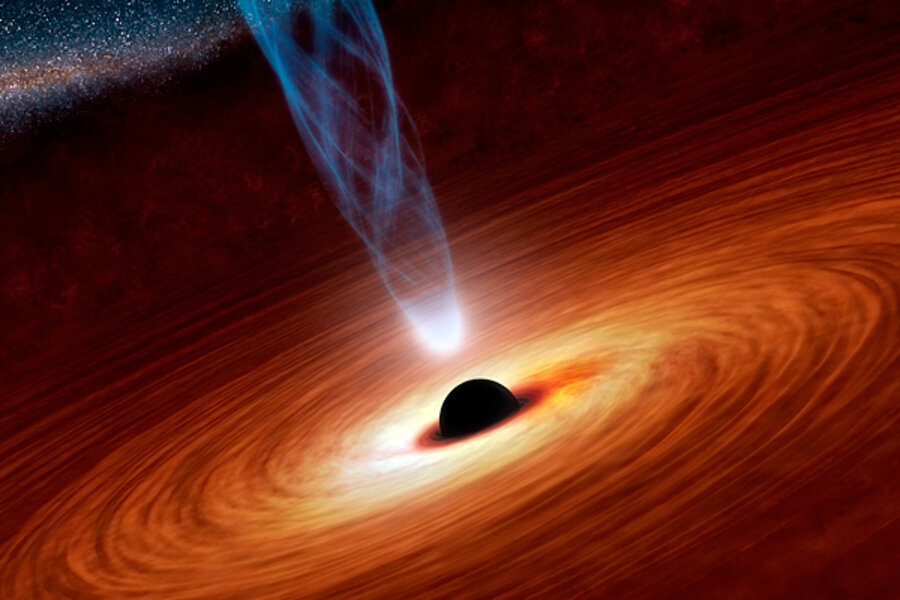How did supermassive black holes get so big? New data give a clue.
Loading...
For the first time, scientists have measured the spin of a supermassive black hole at the center of a galaxy – a measurement that could help explain how these objects got so large.
Supermassive black holes are thought to occupy the center of virtually every galaxy in the universe. They tip the cosmic scales at millions or billions of times the sun's mass.
The supermassive black hole in question spins furiously at the center of the Great Barred Spiral Galaxy, formally known as NGC 1365. It lies some 56 million light-years away in the constellation Fornax. The black hole at its center has 2 million times the mass of the sun.
Putting a miles-per-hour number on the rate of the spin is tough because a black hole has no real surface and no timing markers, explains Fiona Harrison, an astrophysicist at the California Institute of Technology in Pasadena and the lead scientist behind NASA's NuSTAR orbiting X-ray telescope, one of two X-ray telescopes that contributed to the discovery.
Instead, scientists describe the rate in terms of the energy needed to sustain the spin. This black hole's spin is sustained by an amount of energy equivalent to the energy released by a billion stars shining for a billion years, says Dr. Harrison, who is a member of a team reporting the results in Thursday's issue of the journal Nature.
"That's a huge amount of rotational energy," she says.
Indeed, it represents 84 percent of the maximum spin rate predicted by Einstein's theory of general relativity, adds Guido Risaliti, an astrophysicist at the Harvard-Smithsonian Center for Astrophysics in Cambridge, Mass., who was the lead author of the paper in Nature.
The supermassive black hole's high spin rate provides a direct clue as to how it grew, researchers say.
"We believe that these black holes were born when the universe was only about 10 percent of its current age," said Arvind Parmar, mission manager for the European Space Agency's XMM-Newton orbiting X-ray telescope, during a press briefing Thursday afternoon. Back then, Dr. Parmar says, these objects would have tipped the cosmic scales at 20 or 30 times the sun's mass.
They can grow as galaxies collide and their central black holes merge. If both black holes are spinning in the same direction, the merger would result in a black hole with amped-up spin. Likewise, if the black hole continuously feeds on material in its host galaxy in what's called ordered accretion, the spin would accelerate as well. If feeding is random, however, spin rates would be relatively slow.
Thus, for this black hole, the results imply either constant feeding, a merger, or both, Parmar suggests.
Now that researchers have demonstrated that a supermassive black hole's spin can be measured, the next step is to observe these objects in ever more-distant galaxies that span a large stretch of cosmic time.
"This will allow us to probe the importance of accretion and the importance of mergers in creating the universe we see today," he says.
Measuring a supermassive black hole's rate of spin represents a 20-year-old problem in astrophysics that researchers were able to solve with three days' worth of observations from NuSTAR and XMM-Newton.
The X-rays appear thanks to energetic charged particles that are accelerated by a black hole's magnetic field. The particles form into jets that vault into space from the black hole's north and south poles, streaming for distances that can top 1 million light-years.
The region of a jet with the most intense X-ray emissions lies at the end nearest the black hole. These X-rays can in effect be reflected by the swirling disk of material falling into the supermassive black hole.
Meanwhile, the black hole's enormous gravity tugs on the very fabric of space-time itself as the object spins, distorting the disk of infalling material. The largest amount of distortion appears in the region nearest the black hole's event horizon – the point of no return for infalling material. This distortion shows up in the spectra of the disk material, carried by the X-rays that the material reflects. The brightest, most distorted spectra provide a measure of the black hole's spin.
Between the two telescopes, the researchers were able to measure iron's X-ray spectra from the black hole's vicinity with higher precision, in more detail, and over a wider range of X-ray energies than previous instruments could. This not only allowed them to zero in on emissions closest to the black hole, but it also allowed them to rule out competing explanations for the spectra they recorded.








